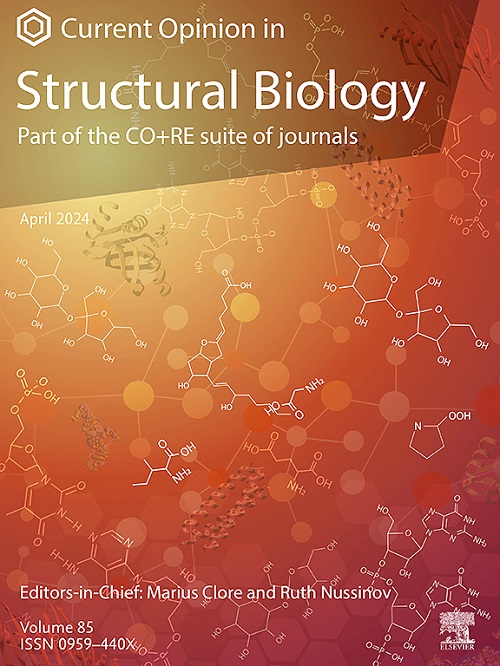基于字典的转录因子识别中DNA固有形状研究方法
IF 6.1
2区 生物学
Q1 BIOCHEMISTRY & MOLECULAR BIOLOGY
引用次数: 0
摘要
序列依赖的内在构象动力学赋予特异性转录因子识别基因组DNA。他们使用全原子模拟来进行基因组规模的研究是具有挑战性的,而将粗粒DNA制成棒状或聚合物模型的替代方法也有其局限性。一种并行方法是我们在这里描述的基于字典的方法。这已被证明可以解释生物系统中的几个转录事件,但尚未得到充分的审查。这些方法代表了基于有限数量的DNA片段及其相应构象性质的研究,通过汇集附近的片段和机器学习模型扩展到基因组。本文旨在组织在生成这些模型方面所做的努力,以及它们最近成功的应用,以刺激该方法的进一步发展。本文章由计算机程序翻译,如有差异,请以英文原文为准。
Dictionary based approaches for studying intrinsic DNA shape in transcription factor recognition
Sequence-dependent intrinsic conformational dynamics confer specificity to transcriptional factor recognition of genomic DNA. Their genome-scale investigation using all-atom simulations is challenging, and alternative approaches by coarse-graining DNA into beads-and-sticks or polymer models have their own limitations. One parallel approach is what we describe here as a dictionary-based approach. This has been shown to explain several transcriptional events in biological systems but has been inadequately reviewed. These approaches represent studies based on a finite number of DNA fragments and their corresponding conformational properties, scaled up to genomes by pooling nearby fragments and machine learning models. This article aims to organize efforts made in generating these models and their recent successful applications to stimulate further development of this approach.
求助全文
通过发布文献求助,成功后即可免费获取论文全文。
去求助
来源期刊

Current opinion in structural biology
生物-生化与分子生物学
CiteScore
12.20
自引率
2.90%
发文量
179
审稿时长
6-12 weeks
期刊介绍:
Current Opinion in Structural Biology (COSB) aims to stimulate scientifically grounded, interdisciplinary, multi-scale debate and exchange of ideas. It contains polished, concise and timely reviews and opinions, with particular emphasis on those articles published in the past two years. In addition to describing recent trends, the authors are encouraged to give their subjective opinion of the topics discussed.
In COSB, we help the reader by providing in a systematic manner:
1. The views of experts on current advances in their field in a clear and readable form.
2. Evaluations of the most interesting papers, annotated by experts, from the great wealth of original publications.
[...]
The subject of Structural Biology is divided into twelve themed sections, each of which is reviewed once a year. Each issue contains two sections, and the amount of space devoted to each section is related to its importance.
-Folding and Binding-
Nucleic acids and their protein complexes-
Macromolecular Machines-
Theory and Simulation-
Sequences and Topology-
New constructs and expression of proteins-
Membranes-
Engineering and Design-
Carbohydrate-protein interactions and glycosylation-
Biophysical and molecular biological methods-
Multi-protein assemblies in signalling-
Catalysis and Regulation
 求助内容:
求助内容: 应助结果提醒方式:
应助结果提醒方式:


